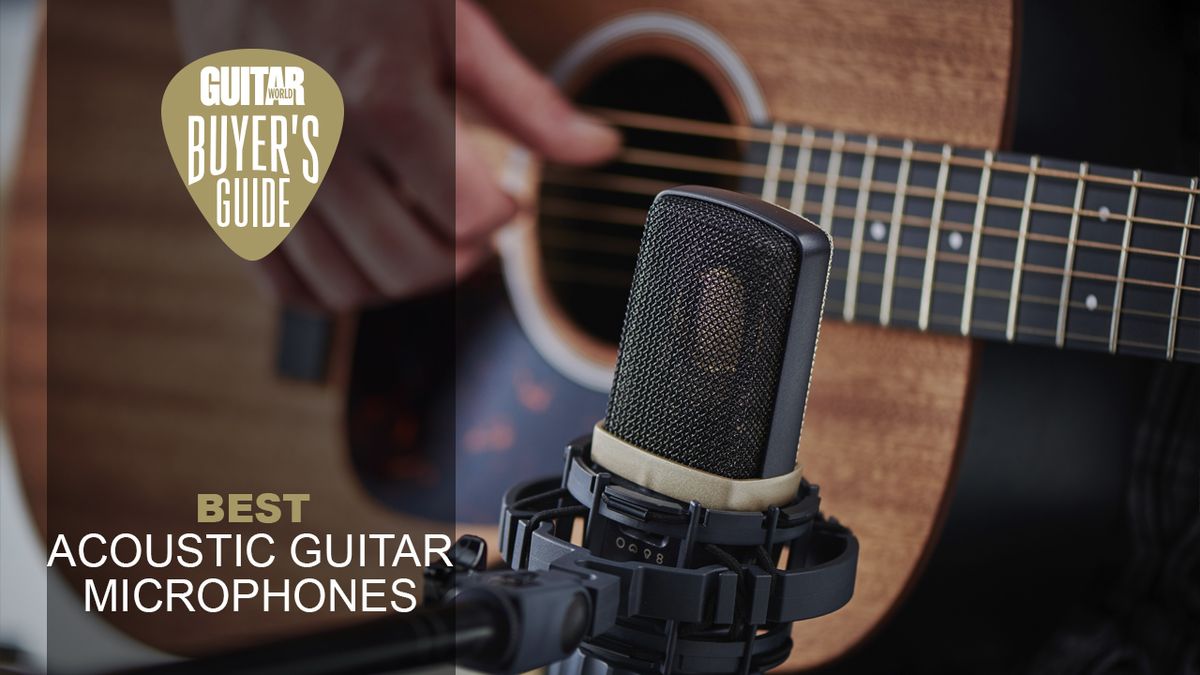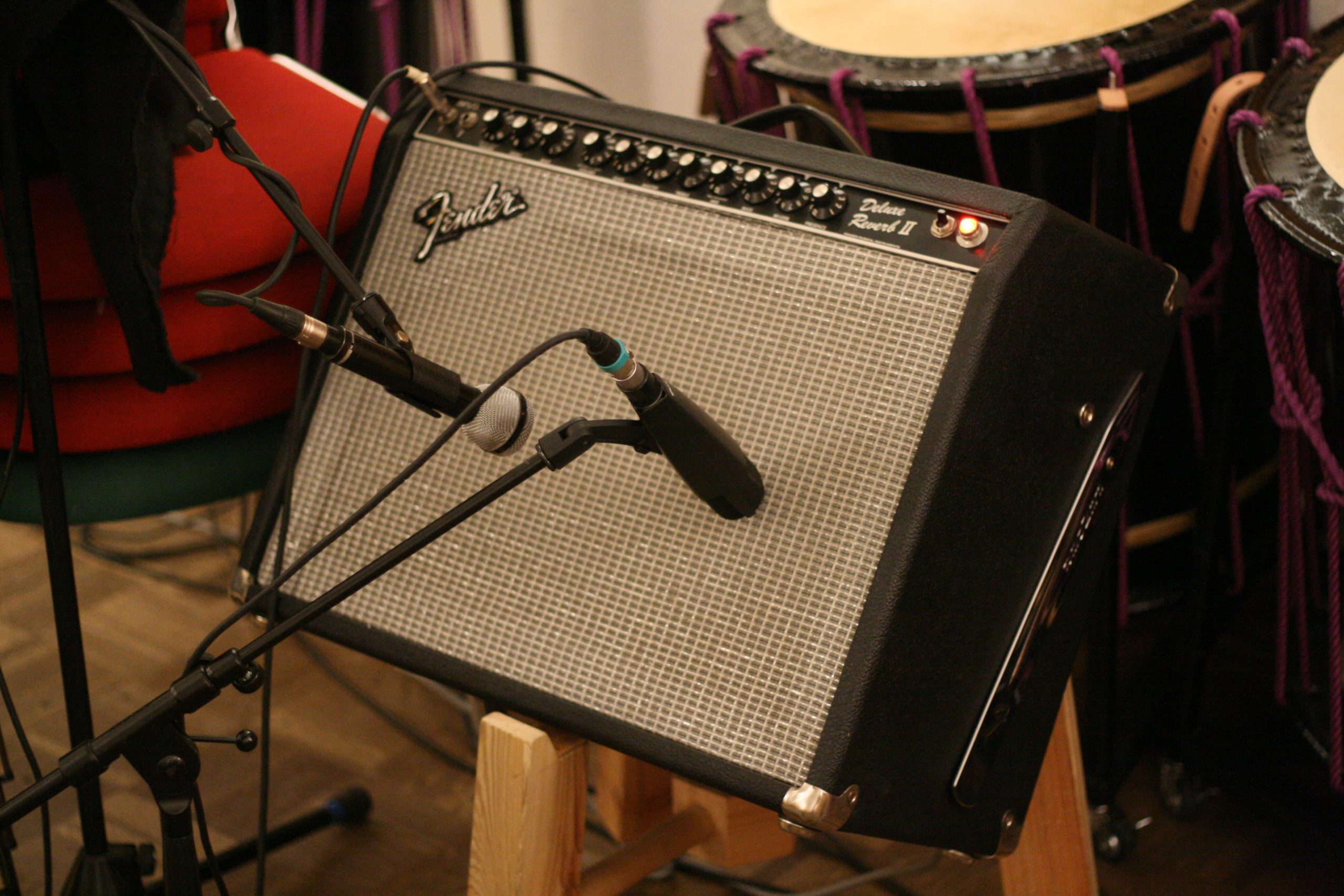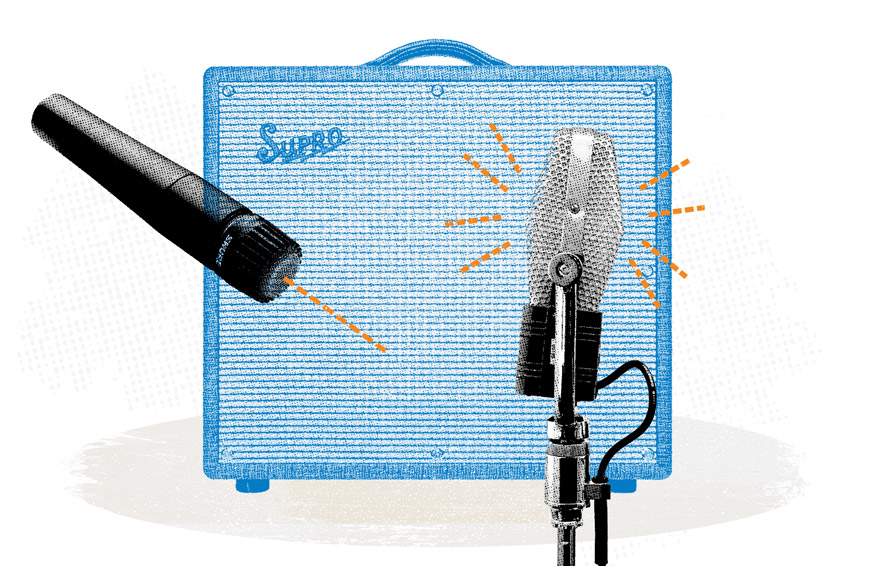The Shure SM57 and the Sennheiser e609 remain top choices for guitar amp mics. These industry standards deliver quality sound and durability.
Selecting the best guitar amp microphone ensures every riff and chord is captured with clarity and definition, which is crucial for both live performances and studio recordings. The Shure SM57 excels with its reliable performance, versatile application, and ability to handle high pressure sound levels.
Perfect for guitar amps, it’s a go-to mic for many sound engineers. The Sennheiser e609, with its supercardioid pattern, offers precise sound capture, reducing bleed from other instruments. It’s specially designed for miking guitar cabs and is highly praised for its ease of use and exceptional sound pickup. Both these mics have earned their place in the music industry, consistently providing the punch and detail that artists and technicians look for when amplifying or recording guitar.

Credit: www.guitarworld.com
The Quest For Perfect Guitar Tone
The journey to capture the essence of a guitar’s soul has always been arduous. Great guitar tone is the Holy Grail for guitarists and audio engineers alike. It’s more than just plugging in and playing. It’s about harnessing the raw, vibrant energy that resonates from the strings, through the amp, and out into the world.
Elements Of Great Amp Micing
Creating the ultimate guitar sound involves meticulous attention to detail. Choosing the right microphone, positioning it accurately, and fine-tuning the amp settings all play crucial roles.
- Microphone type: Dynamics and condensers are go-tos.
- Position: Angle and distance affect the sound character.
- Environment: Room acoustics significantly influence tone.
It’s a balance between science and art.
The Role Of Microphones In Guitar Recording
Microphones are the ears of the recording world. They capture every subtlety and nuance of a guitar’s tone. The right mic can mean the difference between a good take and a great one.
| Mic Type | Characteristics | Best For |
|---|---|---|
| Dynamic | Robust, handles high volume | Live settings |
| Condenser | Detailed, sensitive | Studio recordings |
| Ribbon | Warm, vintage vibe | Mellow tones |
Experiment to find the perfect match for your sound.
Dynamic Mics: Workhorses Of The Studio
Every guitarist knows the power of the right amp set-up. But, capturing that perfect sound isn’t just about the amp. It’s about the mic too. Enter dynamic microphones. These mics aren’t just studio staples; they’re durable, reliable, and perfect for capturing the raw energy of a guitar amp.
Pros Of Dynamic Mics
- Withstands High Volume: They handle loud sounds without distortion.
- Built Tough: Dynamic mics can endure drops and knocks.
- Less Sensitive to Hum: These mics pick up less background noise.
- Cost-Effective: They offer great sound at an affordable price.
- Versatile: Suitable for stage and studio use.
Popular Dynamic Mic Models For Guitars
| Model | Features | Used By |
|---|---|---|
| Shure SM57 | Cardioid pattern, handles high pressure | Professionals worldwide |
| Sennheiser MD 421 | Five position bass roll-off, clear sound | Studio engineers |
| Electro-Voice RE20 | Variable-D for minimal proximity effect | Radio stations and recording artists |
Dynamic mics stand as an excellent choice for capturing guitar amps. Their durability and quality make them go-to choices for musicians and sound engineers alike.
Condenser Mics: Clarity And Detail
When recording or amplifying a guitar, the details in the sound matter. Condenser microphones capture the nuances with crystal clear accuracy. Their sensitivity to sound makes them ideal for picking up the intricacies of a guitar amp.
What Sets Condenser Mics Apart
Condenser mics have a unique build that allows them to pick up sound with high fidelity. This results in a detailed audio capture, perfect for the clear and articulate reproduction of your guitar’s tone.
- Wide Frequency Response: Captures high and low tones clearly.
- Excellent Transient Response: Swiftly responds to the ‘attack’ in your playing.
- High Sensitivity: Ideal for quiet or intricate sounds.
Top Condenser Mic Picks For Amplifiers
| Mic Model | Key Feature | Suitable For |
|---|---|---|
| Audio-Technica AT4050 | Multi-pattern design | Versatile recording |
| AKG C414 | Low noise and high dynamic range | Professional studios |
| Rode NT1-A | Warm sound with high clarity | Home studios |
Each condenser mic offers a blend of characteristics to suit different needs. Audio-Technica AT4050’s versatility stands out for varied styles. AKG C414 shines in professional settings, and Rode NT1-A is a favorite in home studios for its warmth and detail.
Ribbon Mics: Vintage Warmth
The allure of ribbon microphones lies in their iconic sound, reminiscent of classic records from the golden era of music. They envelop guitar amps in a blanket of smooth, mellow tones, providing that sought-after vintage warmth. Let’s unravel the mystery of ribbon mics and discover why they are a favorite for capturing the soul-stirring sounds of guitar amplifiers.
Ribbon Mic Characteristics
Ribbon microphones, known for their rich and natural sound, are a staple in recording studios. Their design includes a thin, lightweight ribbon that moves within a magnetic field. This unique construction translates into a warmth and roundness of tone that solid-state mics struggle to replicate. The following are key traits:
- Figure-8 polar pattern: Captures sound from the front and back, ideal for amp recording.
- Smooth high frequencies: Softens harshness for a pleasant listening experience.
- Fast transient response: Offers a natural capture of intricate guitar sounds.
Ribbon mics do require careful handling and sometimes need preamps with high gain but low noise. They are less ideal for high SPL environments unless specifically designed for it.
Best Ribbon Mics For Amp Capture
When it comes to recording guitar amps, certain ribbon mics outshine their peers. Here are a handful that promise exemplary performance:
| Mic Model | Key Features | Suitable For |
|---|---|---|
| Royer R-121 | High SPL handling, warm and natural sound | Guitar cabs, brass instruments |
| AEA R84 | Versatile, classic vibe | Studio and live sound |
| Beyerdynamic M 160 | Hypercardioid pattern, detailed sound | Strings, pianos, and cymbals |
These ribbon mics offer the warmth that tubes and transistors often miss, especially for guitar amplifiers. Recording enthusiasts cherish them for their ability to produce music that feels as good as it sounds.
Microphone Placement Techniques
Microphone Placement Techniques: Capturing the true essence of a guitar amp’s sound hinges on masterful mic placement. The dance between microphone and speaker can unveil a world of difference in tonal quality. Use creative mic techniques to sculpt the perfect guitar sound for any recording session.
On-axis Vs. Off-axis Positioning
Discovering the right angle:
- On-Axis: Point the mic directly at the speaker center for a bright, defined sound.
- Off-Axis: Angle the mic slightly for a more rounded, warmer tone.
Experiment with these positions to find your ideal amp character.
Distance Micing For Different Sounds
Exploring space measures:
| Distance | Sound Character |
|---|---|
| Close (1-2 inches) | Bass boost, direct sound |
| Medium (1-3 feet) | Balanced, room ambiance |
| Far (4+ feet) | Echo, environment |
Change the distance to fine-tune your sound output.
Mic Combinations For Fullness And Depth
Capturing the true essence of a guitar’s sound often requires more than a single mic. Mic combinations for fullness and depth can transform a flat recording into a dynamic masterpiece. Let’s explore the art of blending different mic types and aligning their phases for the perfect guitar amp sound.
Blending Mic Types
Mixing different microphones can capture the complexity of a guitar amp’s sound. Here’s a guide to some popular pairings:
- Dynamic + Condenser: A dynamic mic provides punchy lows, while a condenser captures crisp highs.
- Ribbon + Condenser: Ribbons offer warm mids, paired with the detail of a condenser.
- Dynamic + Ribbon: This combo allows for a blend of warmth and clear low-end definition.
Phase Alignment Considerations
Proper phase alignment is crucial for a robust sound. Incorrect phase can cause weak or hollow recordings. Follow these steps:
- Position mics at similar distances from the amp.
- Use phase buttons to test and adjust the sound.
- Listen for fullness to confirm correct phase alignment.
By combining mics thoughtfully and managing phase, you can achieve a rich, multi-dimensional guitar sound.
Dialing In The Perfect Mic Settings
Dialing in the perfect mic settings is essential for capturing the essence of any guitar amp. It turns raw power into a polished audio masterpiece. Whether you’re recording in the studio or amplifying live sound, the setup can make or break your guitar’s tone.
Gaining Staging Basics
Gaining the right stage for your mic means starting with the basics. Correct gain staging ensures your signal is strong. It avoids unwanted distortion. Follow these steps:
- Set your amp volume. Aim for the sweet spot where your amp sounds best.
- Set your mic preamp. Gradually increase the gain until the signal is clear yet free from clipping.
- Check the levels. Your mixer or audio interface should show a strong, clean signal.
Adjusting Eq And Filters
EQ and filters shape your sound. They can brighten or mellow the tone. Use them wisely:
- High-pass filters remove low-end rumble. Start around 80 Hz.
- Midrange brings out the guitar’s character. Boost or cut depending on the mix.
- Treble adds sparkle. Adjust until the sound is clear but not harsh.
Remember, every room and guitar amp is different. Take time to test different settings. Trust your ears. With practice, you’ll capture the perfect guitar tone.

Credit: upayasound.com
Case Studies: Famous Guitar Amp Micing Setups
Guitar tones shape music’s emotion and message. Legendary recordings often feature distinct amp micing setups. This section dives into the micing secrets behind iconic guitar sounds. Gain insights from classic rock textures to modern mix triumphs. Let’s explore how pros place mics to capture magical guitar tones.
Classic Rock Sounds
The golden era of rock relied on simple yet effective micing. Artists preferred dynamic microphones for their robust and warm sound.
- Shure SM57: The staple for many rock legends.
- Placed close to the speaker, capturing the grit and punch of guitar riffs.
Jimmy Page of Led Zeppelin used a mixture of distance and close micing. It created a massive presence and dimension. A distance mic captured the room tone.
| Artist | Microphone | Micing Technique |
| Jimmy Page | Shure SM57 | Combo of close and room mics |
Contemporary Production Techniques
Modern technology brings new micing strategies. Producers experiment with multiple mics for a fuller sound spectrum.
- Royaltone Studios: Favored the blend of a dynamic and condenser mic.
- Using a Royer R-121 with a Shure SM57 captures clarity and warmth.
- The condenser mic adds airiness and detail.
John Mayer’s tone combines mics for a smooth yet articulate sound. His technique favors clarity and fullness.
| Artist | Microphone Setup | Production Note |
| John Mayer | Royer R-121 & Shure SM57 | Blending mics for tonal balance |
Maintaining Your Mics For Longevity
To capture the true essence of your guitar amp, a reliable mic is essential. Care for your mics and they’ll last for years. This includes regular maintenance and troubleshooting. Let’s keep your mics performing at their best with these simple steps.
Regular Maintenance Tips
Caring for your guitar amp mics is the key to their longevity. Follow these straightforward maintenance tips:
- Keep Mics Dry: Avoid moisture as it can damage the mic internals.
- Use Protective Cases: Always store in cases when not in use.
- Clean Regularly: Gently wipe your mics to remove dust and spit.
- Handle with Care: Don’t drop mics and detach cables gently.
- Check Connections: Inspect cables and plugs for wear and tear.
Troubleshooting Common Mic Issues
Encounter a problem with your mic? Here’s how to resolve common issues:
| Problem | Solution |
|---|---|
| No Sound | Check cable connections and ensure the mic is on. |
| Distorted Sound | Lower the mic’s input level or move it further from the amp. |
| Interference | Reposition the mic or check for nearby electronic devices. |
| Static Noise | Inspect the cable for damage or try a different cable. |
By keeping these tips in mind, you help your guitar amp mics deliver clear and robust sound in each performance.
Accessorize Your Micing Setup
Accessorizing your micing setup is like adding the perfect condiments to a gourmet burger; it elevates the experience. Guitar amp micing isn’t just about the microphone itself. The accessories you choose breathe life into the sound you capture. This section will guide you through essential add-ons and innovative tools to enhance your guitar amp micing setup.
Essential Mic Accessories
Think of these accessories as the unsung heroes of sound recording. They make the job easier and the result sound sweeter.
- Mic Stands: They must be sturdy and adjustable.
- Shock Mounts: These isolate the mic from vibrations.
- Cables: High-quality cables ensure clear signal transmission.
- Pop Filters: Not typically used for amps, but useful for reducing plosive sounds when recording a guide track.
Innovative Tools For Amp Micing
Here’s where the real magic happens. Innovative tools can take your recording from good to great.
| Tool Type | Purpose | Benefits |
|---|---|---|
| Reflection Filters | Control room sound | Creates dry vocal or instrument sounds |
| Isolation Pads | Prevent mic stand transfer | Reduces rumble and interference |
| Adjustable Mic Bars | Mount multiple mics | Enables stereo micing techniques |
Capturing Live Guitar: Mics On Stage
Every live performance hinges on the bridge between electrifying riffs and the roaring audience. The right mic turns strings into legends. Let’s explore guitar amp mics that bring out the best on stage.
Challenges Of Live Micing
Live micing is a high-wire act. Feedback, noise, and equipment durability test every sound engineer. The perfect mic must capture the guitar’s soul, reject off-axis noise and need to last. Here are common hurdles:
- Feedback Suppression: Crucial for clarity.
- Sound Bleed: Minimize intrusion from other instruments.
- Consistent Output: Ensure reliability during long sets.
Mics To Withstand The Rigors Of Touring
Durability and performance are non-negotiables on tour. Only mics built for the road make the cut. Below are top choices for touring guitarists:
| Mic Model | Features | Why It Rocks |
|---|---|---|
| Shure SM57 | Rugged, Dynamic | Legendary durability, industry standard |
| Sennheiser e906 | Super-cardioid, Flat Shape | Easy positioning, handles high SPLs |
| Audix i5 | VLM Capsule, Dynamic | Clear sound, resilient build |
Future Of Amp Micing Technology
The Future of Amp Micing Technology sparks excitement among guitar enthusiasts and sound engineers alike. Cutting-edge innovations promise to transform the art of capturing guitar sounds, leading to richer, more dynamic audio experiences. Let’s explore these thrilling developments set to redefine amp micing.
Advancements In Mic Design
New microphone designs are emerging that challenge long-standing traditions in amp micing. Manufacturers now focus on crafting mics that enhance frequency response, reduce interference, and provide better isolation. Features like built-in pop filters and shock mounts are becoming standard.
- Multi-pattern Capability: Allows for greater flexibility and experimentation.
- Compact Size: Easier placement without compromising sound quality.
- Durable Materials: Ensures longevity and consistent performance on the road.
Virtual Micing And Modelling
The realm of virtual micing and amp modelling is set for a revolutionary leap forward. Software plugins now emulate classic mic sounds, providing limitless possibilities with minimal gear. Users can switch between legendary mic models with a click.
- Impulse Responses: Capture the essence of physical mics and spaces digitally.
- Customizable Settings: Tailor the sound to the precise needs of each session.
- Real-time Adjustment: Alter mic settings on-the-fly during live performances or recording.

Credit: reverb.com
Frequently Asked Questions For Best Guitar Amp Mics
What Are The Top Guitar Amp Mics?
The best guitar amp mics typically include the Shure SM57, Sennheiser e609, and Royer R-121. These mics are favored for their durability, sound quality, and ability to handle high sound pressure levels, making them industry standards for guitar amp recording and live performances.
How To Choose A Mic For Guitar Amps?
When choosing a mic for guitar amps, consider the mic’s frequency response, polar pattern, and maximum SPL. Dynamic mics are often preferred for their ruggedness and ability to capture loud sounds, while ribbon mics offer a smooth, natural response for more nuanced recordings.
Are Condenser Mics Good For Guitar Amps?
Condenser mics can be excellent for guitar amps, especially in studio settings. They offer a wider frequency response and higher sensitivity, which can be advantageous for capturing the amp’s full tonal range. However, they may require more careful handling and positioning due to their sensitivity.
Can I Use A Vocal Mic For Guitar Amps?
Yes, you can use a vocal mic for guitar amps, particularly if it’s a dynamic model like the Shure SM58. While not tailored specifically for guitar amps, these mics can still produce a decent sound and may offer versatility if you’re working with a limited mic collection.
Conclusion
Selecting the perfect guitar amp mic can elevate your sound to new heights. With the options we’ve explored, finding your match is simpler than ever. Remember, the right choice blends seamlessly with your style and setup. Dive in, test out our top picks, and let the music speak for itself.
Time to amplify your talent!